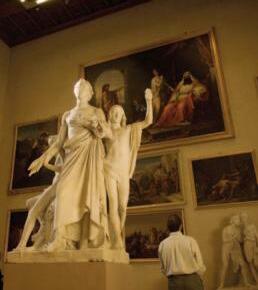
19 minute read
Art
Unless noted, all programs are presented on Zoom; listed times are Eastern Time. Online registration is required.
SmithsonianAssociates.org/artcertificateArt-full Fridays | Live from Italy, with Elaine Ruffolo
World Art History Certificate elective: Earn ½ credit
The Three Greatest Paintings in Florence
For centuries, the city of Florence nurtured an unceasing succession of great artists. No other place can rival it for the quantity of first-rate, locally created works of art.
You might wonder, which of the hundreds and hundreds of Renaissance masterpieces in Florence are considered the most significant? Join Renaissance art historian Elaine Ruffolo for an in-depth look at three paintings and learn why she considers them the most important in the city. Can you guess which? Fri., Jan. 20, 12–1:15 p.m.; CODE 1H0-757; Members $20; Nonmembers $25
Gallery of the Academy of Florence
Frederic Church’s Olana
A Masterwork of American Landscape and Design
Frederic Church (1826–1900) was America’s preeminent landscape artist of the 19th century, whose “great paintings” of the 1850s and 1860s (Niagara, Heart of the Andes, Icebergs) achieved international acclaim. Beginning in 1860, he spent the last 40 years creating Olana in Hudson, New York, a 250-acre designed landscape with panoramic views of the Hudson Valley and Catskills.
Today, Olana is the country’s most intact artist’s environment and a National Historic Landmark. Sean Sawyer, president of the Olana Partnership, provides an overview of this landmark in American preservation history. Fri., Jan. 6, 12–1:30 p.m.; CODE 1NV-015; Members $25; Nonmembers $30
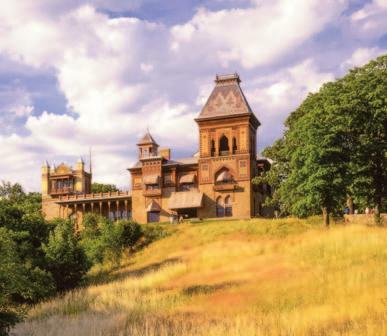
World Art History Certificate core course: Earn 1 credit The Women Who Made Art History
From the Renaissance to the 21st Century
We live in a moment in which formerly marginalized groups of artists, including people of color and women, are being celebrated. But for centuries, women were conspicuously underrepresented in—and indeed almost absent from—art history books. Yet despite the multitude of barriers that kept women from achieving prominence, a critical mass—from Artemisia Gentileschi and Judith Leyster to Mary Cassatt, Frida Kahlo, Cindy Sherman, and many more—did find their way into the annals of art history. Art historian Judy Pomeranz explores the works and lives of female artists who made significant marks on the course of art history. JAN 10 Renaissance to mid-19th Century JAN 17 Late 19th Century to Early 20th Century JAN 24 Modern Artists up to the mid-20th Century JAN 31 Abstract Expressionists and Those Who Came After 4 sessions: Tues., Jan 10–31, 12–1:30 p.m.; CODE 1H0-753; Members $80; Nonmembers $90
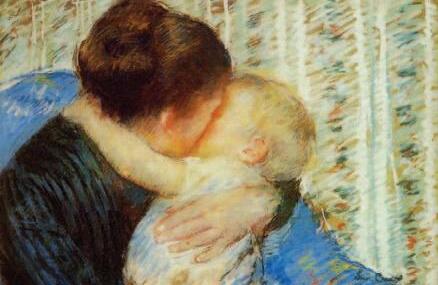
Mother and Child (A Goodnight Hug) by Mary Cassatt, 1880
Write Into Art
Creative Writing Inspired by Visual Art
Discover how visual art can inspire creative writing and how writing can offer a powerful way to experience art. Join Mary Hall Surface, the founding instructor of the National Gallery of Art’s popular Writing Salon, for online workshops that explore essential elements of writing and styles through close looking, word-sketching, and imaginative response to prompts.
The sessions spotlight a diverse range of visual art chosen to inspire writers of all experience levels to deepen their process and practice. Each workshop has a limited enrollment to maximize interaction among the instructor and students. JAN 10 Place: Unveil Layers JAN 17 Time: Flashback and Forward JAN 24 Character: Discover Dimensions JAN 31 Story: Imagine Possibilities FEB 7 Poetry: View from Above 5 sessions: Tues., Jan. 10–Feb. 7, 10–11:30 a.m.; CODE 1K0323; Members $175; Nonmembers $185 Individual sessions: Tues., Jan. 10 (CODE 1K0-324); Tues., Jan. 17 (CODE 1K0-325); Tues., Jan. 24 (CODE 1K0-326); Tues., Jan. 31 (CODE 1K0-327); Tues., Feb. 7 (CODE 1K0328); 10–11:30 a.m.; Members $40; Nonmembers $45 Mary Hall Surface
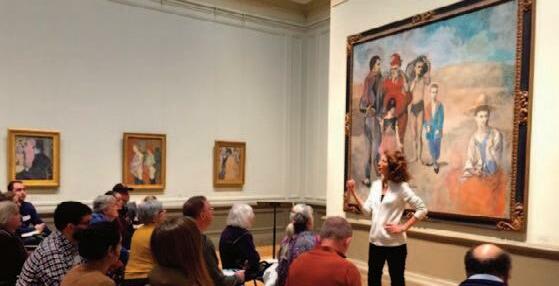
June 20-August 18
Summer Camp is ready to bring the Smithsonian’s world to life! Visit SmithsonianAssociates.org/camp
to view camps and plan your special Smithsonian experience this summer!
Online Registration February 14*–17
*Early registration for Smithsonian Associates members at the Contributor Level ($300) or above starts February 14 at 10 a.m. ET. All registrations are online only. For information on how to become a Contributor Level member, please call 202 –633–3030 (M-F, 10-3)
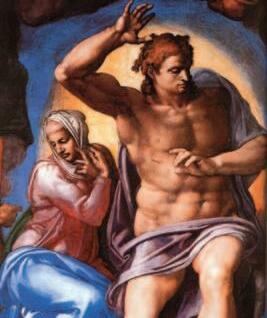
Mary and Christ (detail) from The Last Judgment by Michelangelo World Art History Certificate elective: Earn ½ credit The Transformation of Christ in Art
From the Catacombs to Caravaggio
The depiction of Jesus in Western art underwent dramatic transformation from the earliest known images through the Baroque period of early modernity. What unique social and artistic influences shaped these changes? The answers are far more complex than mere artistic representation.
Historian Cheryl White examines diverse depictions of Christ’s images across time in the context of their socio-cultural environments. Her survey begins in Rome’s ancient catacombs and continues through Da Vinci’s Last Supper and Michelangelo’s The Last Judgment. Wed., Jan. 11, 6:30 p.m.; CODE 1M2-247; Members $25; Nonmembers $30
World Art History Certificate elective: Earn 1 credit Spanish Art and Architecture: A Treasury of Delights
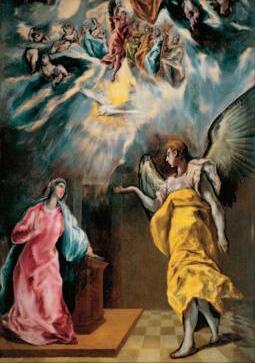
The art and architecture of Spain as seen in the works of El Greco, Goya, Velazquez, Picasso, and Gaudi offer a window into the influences that define the country’s history and national identity. Art historian Joseph Cassar highlights artists and structures that exemplify Spain’s distinctive cultural heritage. 10 a.m. El Greco and Velazquez 11:15 a.m. Goya and Picasso 12:15 p.m. Break 12:45 p.m. Santiago de Compostela and the Alhambra Les Demoiselles d'Avignon by Pablo Picaso, 1907 Annunciation by El Greco 2 p.m. Gaudi in Barcelona Fri., Jan 13, 10 a.m.–3 p.m.; CODE 1H0-756; Members $80; Nonmembers $90
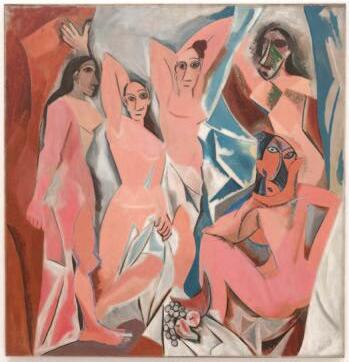
Mid-century Modern
Sleek, Stylish, and Accessible
Mid-century Modern architecture in the United States was a reflection of the International Style that originated with the Bauhaus movement in Europe following World War I. The style gained wide following among upscale and custom-built homes but also encompassed thousands of homes designed for GIs returning from World War II. It was also spread by design principles and color palettes saturating everything from kitchen appliances to furniture and airline paint schemes. Join Bill Keene, a lecturer on architecture and urban studies, for a discussion of the wider implications of Mid-century Modern design trends. Fri., Jan. 13, 12–1:30 p.m.; CODE 1NV-016; Members $25; Nonmembers $30

Dulles Airport, designed by Eero Saarinen, is an example of Mid-century Modern architecture
World Art History Certificate elective: Earn 1 credit Renaissance Rome
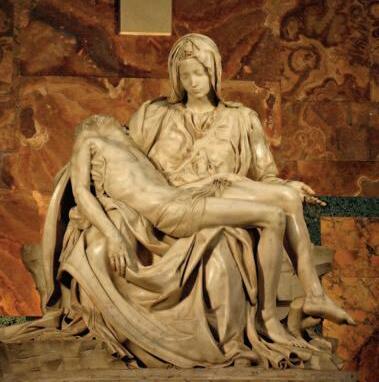
The Pietà by Michelangelo
The return of the papacy in the 15th century transformed Rome from a dilapidated town littered with ruins to a city at the center of the Renaissance movement in Europe. The pope and cardinals spent lavishly as Bramante, Michelangelo, and Raphael were given one commission after another to complete and beautify the city of God. Michelangelo, who elevated both painting and sculpture to an unprecedented level of beauty, expression, and power, transformed Rome into the leading art capital of Europe.
Rocky Ruggiero, a specialist in early-Renaissance art, examines this pivotal time in art history as it swept across Rome. 10 a.m. Renaissance Ambassadors to Rome 11:15 a.m. Michelangelo and the High Renaissance in Rome 12:15 p.m. Break 1:15 p.m. Raphael: The Prince of Painters 2:45 p.m. Building St. Peter’s Sat., Jan. 21, 10 a.m.–4 p.m.; CODE 1J0-228; Members $80; Nonmembers $90

Art Crimes: Iconic International Art Heists
Is the case ever really closed? Join one of the most famous art detectives in the world to hear tales from the trenches of the most notorious art heists in modern history.
Expert on art fraud, award-winning author, and former FBI agent Robert Wittman provides an up-close vantage point for the engrossing reconnaissance strategies behind the cases he worked on personally or followed as the FBI’s art-crime specialist— collaborating with agencies such as Scotland Yard and the Norwegian National Police. He also provides behind-the-scenes insights into cases that remain unsolved today. Wed., Feb. 1, 6:45 p.m.; CODE 1K0-330; Members $20; Nonmembers $25
The Scream by Edvard Munch was stolen and recovered in 1994

NATIONAL GALLERY, OSLO World Art History Certificate elective: Earn ½ credit Astrology in Renaissance Art
Representation and Meaning
The study and practice of astrology re-entered Western Europe in the early 12th century, primarily via Spain, where Arabic and Jewish scholars had preserved ancient astrology. Controversies over the Arabic theory of planetary conjunctions, especially that of 1484, which predicted the end of the Christian religion, helped to drive European developments in the practice of astrology and its representation in art. Art historian Claudia Rousseau explains what astrology actually is, how it works, and its mathematical basis, as well as how it was represented in art in the Renaissance era. Thurs., Feb. 9, 6:45 p.m.; CODE 1J0-232; Members $20; Nonmembers $25
All Smithsonian Associates Streaming programs are closed captioned
World Art History Certificate elective: Earn ½ credit Marisol: A Pop Art Superstar
She was glamorous, sophisticated, andMarisol Escobar wickedly funny. Marisol Escobar, known simply as “Marisol” (1930–2016), survived a traumatic childhood to become a successful female Pop artist and darling of 1960s New York’s avant-garde. Her life-sized, carved and painted wood portraits of world leaders, Hollywood celebrities, and herself combine brilliant draftsmanship with a keen sense of color and texture.
Art historian Nancy G. Heller examines Marisol’s major works to define her place within the broader context of Pop Art and 1960s American society. Thurs., Feb. 9, 12–1:30 p.m.; CODE 1M2-242; Members $20; Nonmembers $25 World Art History Certificate elective: Earn ½ credit War and Pieces
The Met Cloisters and the Lens of History
At the 1938 public opening of The Met Cloisters—the branch of the Metropolitan Museum devoted to the art of medieval Europe—not a word was spoken about the threat of war looming over the continent. Yet, ironically, The Met Cloisters’ very foundations stand in witness to the devastating impact of centuries of war and revolution on artistic heritage. Barbara Drake Boehm, Met Cloisters curator emerita, considers some of its artworks against the backdrop of history, with special attention both to the dangers that beset them and the circumstances that preserved them. Fri., Feb. 10, 12–1:30 p.m.; CODE 1NV-014; Members $25; The Gothic Chapel Nonmembers $30

World Art History Certificate elective: Earn 1 credit The Regency World of Jane Austen
Art, Architecture, Culture
Emma Woodhouse, Elizabeth Bennet, Anne Elliot, and the Dashwood sisters may be fictional heroines, but their creator Jane Austen set their adventures in romance against the very real social and historical backdrop of Regency England.
Art historian Bonita Billman brings the era to life during a delightful day of cultural time travelling. She surveys Regency manners and fashions, the personalities who dominated the public imagination, and the stylish spa town of Bath, where many of Austen’s characters made appearances. Her discussions of customs and manners, interior decoration and fashion, and social life and everyday life provide a cultural context for those characters. 9:30 a.m. The Period’s Personalities 11 a.m. Regency Portraiture 12:15 p.m. Break 1:15 p.m. Late-Georgian Architecture 2:45 p.m. The Fabric of Regency Life Sat., Feb. 11, 9:30 a.m.–4 p.m.; CODE 1M2-239; Members $80; Nonmembers $90

Drawing of Jane Austen by her sister Cassandra, 1810
NATIONAL PORTRAIT GALLERY LONDON
What time does the program end? Unless noted, Smithsonian Associates programs run 1 hour 15 min.–2 hours, including Q&A
World Art History Certificate elective: Earn ½ credit Ancient Art Collections of Rome
In this new quarterly series, Renaissance art expert Rocky Ruggiero spotlights the significant collections of Rome’s sometimes-overlooked museums.
Many of Rome’s lesser-known museums contain some of the world’s most important Greco-Roman art. From the Equestrian Monument of Marcus Aurelius in the Capitoline Museums to Emperor Augustus’ giant Ara Pacis (“Altar of Peace”) in the museum that takes its name from the work, to the most significant collection of Etruscan art in the world at the Villa Giulia, Ruggiero, Renaissance art expert, explores the ancient art collections of Rome’s most important museums of antiquities. Mon., Feb. 13, 6:30 p.m.; CODE 1J0-233; Members $30; Nonmembers $35 The façade of the Ara Pacis Augustae
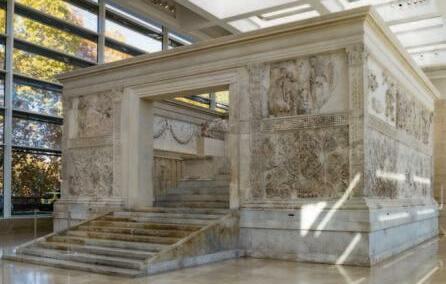
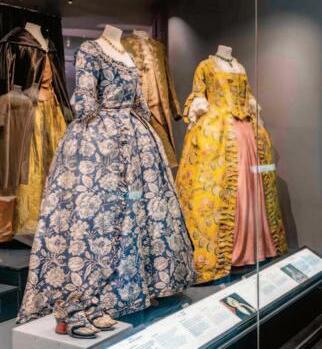
The Fashion Museum, Bath
Julia Brennan and master batik makers review a historic batik reproduction owned by the U.S. Embassy in Jakarta.
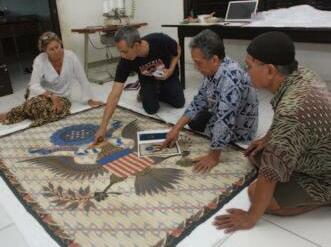
Lunchtime with a Curator
Decorative Arts Design Series
Join curator Elizabeth Lay, a regular lecturer on the topics of fashion, textiles, and American furniture, for image-rich lectures focusing on decorative arts and design topics.
England’s Fashion Museum Bath holds one of the world’s great collections of historical and contemporary fashionable dress. In a special transatlantic conversation, Lay speaks with Rosemary Harden, senior curator and Fashion Museum manager, about the museum’s world-famous collections.
Throughout history, beds conveyed wealth and status and, for many, were the most expensive object in the home. Textile historian Natalie F. Larson looks at the variety of sleeping arrangements from slave dwellings and Indigenous populations to the homes of middle-class and upwardly aspiring Virginians.
Finally, learn how textile conservation is a form of cultural diplomacy, cultivating and honoring people and heritage. Textile conservationist Julia M. Brennan describes how she has worked to build cultural bridges by engaging in both high-profile and grassroots projects to help set up conservation labs, train local specialists, and preserve local and regional textile heritage. FEB 13 The Glorious Collection of the Fashion Museum Bath FEB 27 Sleeping Around Virginia MAR 13 Textile Diplomacy 3 sessions: Mon., Feb. 13, 27, and March 13, 12–1 p.m.; CODE 1K0-339; Members $45; Nonmembers $55 Individual sessions: Mon., Feb. 13 (CODE 1K0-340); Mon., Feb. 27 (CODE 1K0-341); Mon., March 13 (CODE 1K0-342); 12–1 p.m.; Members $20; Nonmembers $25
Advantages to providing your email to customer service:
• Receive a digital version of the member program guide so you can read it anywhere • Receive important notices regarding your ticket purchases along with other useful information

A Visit from the Old Mistress by Winslow Homer, 1876 In-person Program World Art History Certificate elective: Earn 1/2 credit Winslow Homer
Capturing an America in Transformation
Painter Winslow Homer (1836–1910) was raised in the years before the Civil War and came of age in a nation in crisis. Like Twain and Whitman, he captured the landscape of a rapidly changing country.
Author William R. Cross examines Homer’s role in American culture as a witness to the times in which he lived and the challenge of achieving a just and equitable society.
Cross’s biography Winslow Homer: American Passage (Farrar, Straus and Giroux) is available for purchase and signing. Wed., Feb. 22, 6:45 p.m.; McEvoy Auditorium, Smithsonian American Art Museum; CODE 1L0-503: Members $20; Nonmembers $25
World Art History Certificate elective: Earn ½ credit Wildfire: The Life and Works of Edmonia Lewis
Edmonia Lewis, born free in upstate New York in 1844, was an American sculptor of Native American (Mississauga Ojibwe) and African-American heritage. Known by her Ojibwe name, “Wildfire”, she spent most of her life in Rome working with a group of expatriate female Neoclassical artists. Her marble sculptures attracted prominent Edmonia Lewis by Henry Rocher European patrons. Art historian Nancy G. Heller discusses the renewed interest in her work and her place in art history. Thurs., Feb. 23, 12–1:30 p.m.; CODE 1M2-243; Members $20; Nonmembers $25
We are proud to work with C-SPAN. This digital library offers a selection of our past programs on a wide variety of intriguing topics. Learn more at SmithsonianAssociates.org/replay
SMITHSONIAN AMERICAN ART MUSEUM World Art History Certificate core course: Earn 1 credit Understanding Contemporary Art
From Pop to Pluralism
Avant-garde American art of the 1960s was dominated by two contradictory impulses. Miss Lillian, 1977, by On one side, a group of young artists Andy Warhol returned to representational art, but with a cool and decidedly modern twist known as Pop. At the same time, the so-called minimalists created a new kind of abstraction, paring down their works to just a few carefully considered colors and forms.
Then, beginning in the 1970s, artists explored an enormous range of new materials, techniques, and styles. That pluralistic experimentation encompassed forms from conceptual and super-realist art to environmental and performance art, all of which still resonate today.
Art historian Nancy G. Heller looks at the roots and later influences of radical American art from the last five decades. FEB 28 Soup Cans and Comic Strips: The Revolutions of Pop Art and Minimalism MAR 7 Introduction to Pluralism: The Extremes MAR 14 Taking Art Out of the Gallery and Museum Jeff Koons’ sculpture Puppy in front of the MAR 21 Feminist Art and the Influence of Guggenheim Museum, Identity Politics Bilbao, Spain MAR 28 Erasing Boundaries: Redefining Art 5 sessions: Tues., Feb. 28–March 28, 12–1:30 p.m.; CODE 1M2-244; Members $85; Nonmembers $95
Women in the Fields by PierreAuguste Renoir, 1919 World Art History Certificate elective: Earn ½ credit (for each program session) Masterworks by Renoir, Cézanne, and Matisse at the Barnes Foundation
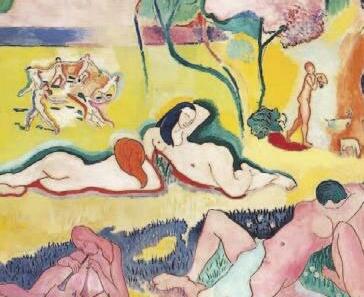
Drawing on what is considered one of the greatest postImpressionist and early modern art collections in the world, Barnes Foundation educator Penny Hansen guides live virtual tours through the galleries, examining in depth the paintings of three revolutionary artists. Using high-definition Deep Zoom technology developed by the Barnes, Hansen provides astonishingly close-up views of the canvases, revealing their paint surface, brushstrokes, and details in ways that bring the art and the artist vividly to life. All programs provide the chance to interact with Hansen in a Q&A session. MAR 9 Matisse MAR 16 Renoir MAR 23 Cézanne
Nature morte au crane, by Paul Cézanne, 1896-98
Le bonheur de vivre (detail), by Henri Matisse, 1906 3 sessions: Thurs., March 9, 16, and 23, 12–1:30 p.m.; CODE 1NV-BAR; Members $75; Nonmembers $90 Individual sessions: Thurs., March 9 (CODE 1NV-022); Thurs., March 16 (CODE 1NV023); Thurs., March 23 (CODE 1NV-024); 12–1:30 p.m.; Members $30; Nonmembers $35
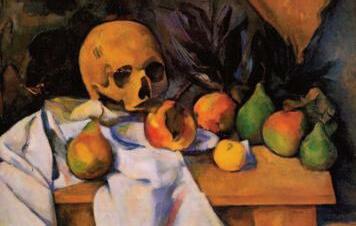
World Art History Certificate elective: Earn ½ credit The Tale of Shuten Doji
The 14th-century Japanese legend about warrior Raik’s conquest of a terrifying, flesh-eating ogre is recounted in The Tale of Shuten Doji. During the Edo period (ca. 1600–1868) the story’s popularity inspired many painted scrolls, folding screens, wood-block prints, and other media.
The tale may appear to be a typical retelling of warrior heroes battling savage demons, but a closer look reveals a more complex picture of socially marginalized groups and notions of otherness. Art historian Yui Suzuki focuses on illustrations that convey the story’s conventional and cryptic meanings. Tues., March 14, 6:45 p.m.; CODE 1J0-246; Members $20; Nonmembers $25 The Tale of Shuten Doji, Edo period, 17th century
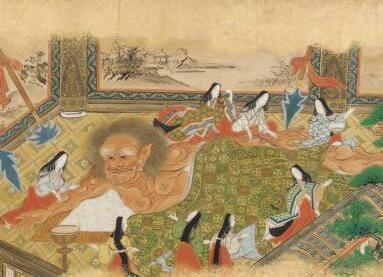
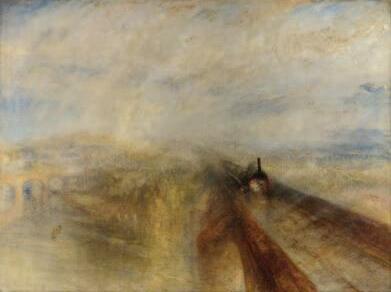
Rain, Steam and Speed–The Great Western Railway by J.M.W. Turner, 1844
J.M.W. Turner and the Art of the Sublime
British artist J.M.W. Turner (1775–1851) is known for innovative landscape paintings that captured nature’s power and drama. His radical techniques allowed him to create unprecedented imagery that still appears modern today.
Art historian Tim Barringer places a selection of Turner’s works in historical context. He reveals how Turner’s art reflected his belief in “the sublime,” an artistic theory that contrasted the power of nature with the fragile condition of mankind, and how in paintings such as Rain, Steam and Speed (1844) he evoked the drastic transformations caused by the Industrial Revolution. Thurs., March 30, 6:30 p.m.; CODE 1H0-759; Members $20; Nonmembers $25
World Art History Certificate core course: Earn 1 credit The History of Western Architecture
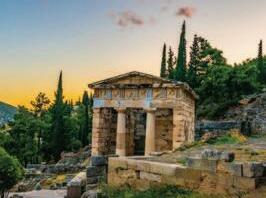
Tracing the history of Western architecture is like looking back at a long trail of footprints in the sand. Each step marks a particular moment of the journey, just as architectural movements and styles mark distinct moments in Western history. By examining four distinct historical periods in Western architecture, art historian Rocky Ruggiero traces the development of architectural styles, traditions, trends, and forms beginning in the ancient world and continuing through to the present day. MAR 21 The Ancient World Athenian Treasury at ancient Delphi MAR 28 The Medieval World APR 4 The Early Modern and Baroque Worlds APR 11 The Modern World 4 sessions: Tues., March 21–April 11, 6:45 p.m.; CODE 1J0-248; Members $80; Nonmembers $90
La Salve Bridge over the Nervion River, Bilbao, Spain
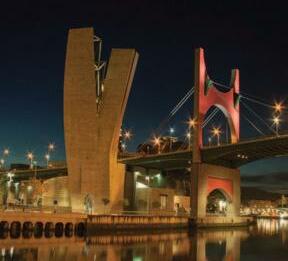
World Art History Certificate elective: Earn 1 credit Ancient Egypt Through its Art and Architecture
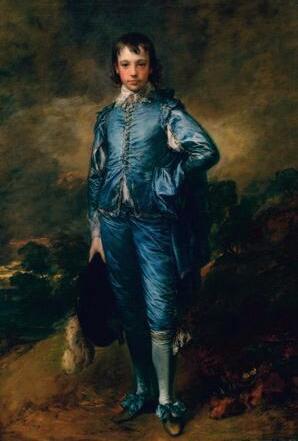
The secret to understanding the daily life and culture of ancient Egypt under its great rulers and pharaohs is right before our eyes—in its art and architecture. Examinations of these vast treasures reveal how they influenced Egyptian The Great Sphinx monument (1397– cultural identity and how 1388 B.C.) and a pyramid at Giza religion shaped artistic production.
Using evidence from the most recent archaeological discoveries, Egypt specialist Jacquelyn Williamson surveys the social and historical realities of this civilization from its early pyramids through its art created under King Akhenaten, who upended centuries of tradition to create new artistic conventions. 9:30 a.m. Understanding Egyptian Art: The Origins of an Artistic Tradition 11 a.m. Wonder and Majesty: The Art of the 4th Dynasty 12:15 p.m. Break 1:15 p.m. The Elegance of Discord and the Beauty of Empire 2:45 p.m. The Art of Heresy: Akhenaten and Egyptian goddess Nefertiti Maat, 664–332 B.C. Sat., March 11, 9:30 a.m.–4 p.m.; CODE 1M2-240; Members $80; Nonmembers $90

WALTERS ART GALLERY World Art History Certificate elective: Earn ½ credit Thomas Gainsborough: Beyond the Blue Boy
British artist Thomas Gainsborough (1727–1788) was widely known and admired for his fluid handling of paint in his portraits and landscapes. He and rival Joshua Reynolds dominated portrait painting in the 1770s and 1780s.
The largely self-taught, witty, convivial Gainsborough’s patrons included musicians, actresses, artists, the aristocracy, and the royal family. He became famous in the United States when one of the Gilded Age’s notoriously wealthy robber barons purchased the iconic Blue Boy (1770).
Art historian Bonita Billman examines Gainsborough’s career and his influence on painting. Thurs., March 23, 12–1:30 p.m.; CODE 1M2-252; Members $20; Nonmembers $25
The Blue Boy by Thomas Gainsborough, 1770





